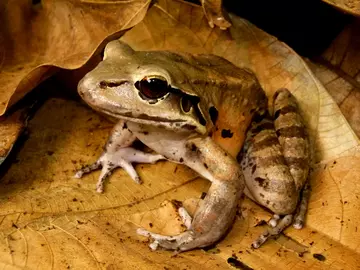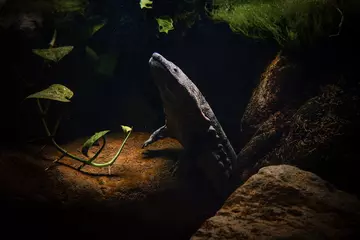
London Zoo's newest major exhibit 'The Secret Life of Reptiles and Amphibians' is currently under construction.
The nights may be drawing in, but work isn’t slowing down on London Zoo’s main lawn. If you’ve visited recently, you may have noticed the building work going on next to our Diana monkeys and mangabeys. By spring next year the Terrace Restaurant, Zoo Shop and Giants of the Galápagos will share Barclay Court with London Zoo’s newest major exhibit: The Secret Life of Reptiles and Amphibians.
The new exhibit will house 26 species and use the latest technology to bring to life eight different habitats – from the steamy forests of South America to the mountain jungles of Asia. For now though, the building is a jungle of wires, step ladders and spotlights, populated by hard-hatted builders, zookeepers and horticulturalists intent on building the perfect home for some of the world’s most threatened reptiles and amphibians.

Perhaps the rarest of these species is the mountain chicken, a gigantic species of frog from the Caribbean. Mountain chickens have been driven to the brink of extinction by a deadly fungus and there are thought to be less than 100 left in the wild. Our zookeepers and conservation scientists are part of the mountain chicken recovery programme, a partnership set up with other zoos and organisations, and we have been working to save the species for over a decade. Part of our role has been breeding a healthy population behind the scenes at London Zoo, – but this is the first time visitors will be able to see them up close. In 2019, 27 mountain chicken frogs that were bred at ZSL London Zoo were sent to the island of Montserrat as part of a reintroduction programme.
Mountain chicken frogs are one of over 500 amphibian species badly affected by amphibian chytrid fungi. Chytrid fungi infect the skin of amphibians and can lead to death if left untreated. Visitors will be able to learn about how our scientists and our partners are trialling the use of heated pools on Monserrat as a way of combatting the fungus. Chytrid fungi are sensitive to heat, and warm water heated to around 30oC kills the fungi without harming the frogs. If it’s proven that the heated pools are successfully used by the frogs to fight off the infection, the technique could revolutionise approaches to conserving amphibians around the world.
Another newcomer for visitors to look out for is the beautiful-but-deadly Mangshan viper, one of the world’s rarest venomous snakes. Hailing from a single mountain – Mt. Mang – in the misty mountain ranges of southern China, London Zoo is the only Zoo in the UK to look after Mangshan vipers. Their mottled green scales help to camouflage them against the moss that carpets their inaccessible mountain home. And their ingenuity doesn’t stop there – the tip of their tail is a bright white, which the snake can twitch to lure unsuspecting rodents and birds to within striking distance. Once in range, the Mangshan viper will strike, using long, hollow fangs to inject their prey with the venom produce in glands at the back of their heads; before consuming the unlucky animal whole!

Caring for all of these creatures requires a high level of knowledge from our keepers. Each animal has unique needs – for example, the Lake Oku frog will only eat aquatic invertebrates, while the big-headed turtle prefers a diet of fish and crayfish. The Ethiopian mountain viper, which lives at high altitude in eastern Africa, likes a cool night time temperature of 13°C, while the Philippine crocodile prefers a toasty 30°C. Our reptile and amphibian keepers have led the design of each enclosure, using their own experiences of working with the animals in the Zoos and in the field, and all of the research available on each species, to create their ideal home.
One thing that we take for granted but is particularly important for amphibians, like the Chinese giant salamander, or aquatic reptiles like the Philippine crocodile, is water. Aquatic animals often have very specific needs in terms of the type of water they live in. For example, the pH (a scale of water acidity and alkalinity) of the water in Lake Titicaca in South America is very different to the pH of water found in the Amazon River, and we have to recreate that water if the animals are to thrive. Secret Life of Reptiles and Amphibians has its own water filtration system which removes chemicals and minerals from the water. Once purified, minerals can be added back in so that the water suits the individual needs of each species. Finally, once the water in our reptile and amphibian enclosures has been used and needs to be disposed of, the water is cleaned again before it enters the sewage system.

At the heart of Secret Life of Reptiles and Amphibians is our mission to protect the immense diversity of the reptile and amphibian world. Which is why, on entering the new exhibit, one of the first things visitors will see is our breeding rooms – containing species like big-headed turtles and Sardinian brook salamanders. Both species are considered highly threatened by conservationists, with the salamander particularly at risk from chytrid fungi, while the big-headed turtle has been poached for meat and for the exotic pet trade. By caring for them in our new state-of-the-art London Zoo facility, we can work with other zoos across Europe to maintain safety net populations of some of the world’s most incredible and threatened species, while learning more about them to ultimately better protect them in their wild habitats.
